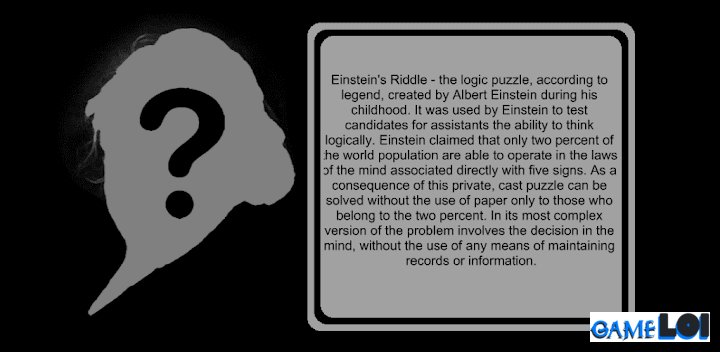Introduction to Einstein’s Riddles
In the entertaining game Einstein’s Riddles, players are challenged to unravel the intriguing legends of Albert Einstein himself. This game provides a unique blend of logic, deduction, and problem-solving, set against the backdrop of Einstein’s brilliant and enigmatic legacy. Players are given the opportunity to engage in a mental exercise that showcases their reasoning skills, reminiscent of the thought experiments that Einstein himself might have employed.
The Legend of Einstein’s Riddles
It is widely believed that these riddles were devised by Einstein as a method to evaluate the intelligence and problem-solving capabilities of potential assistants. The anecdotes surrounding these riddles suggest that Einstein valued analytical thinking and creativity, placing strong emphasis on mental acuity rather than rote memorization or external aids. This element of the game not only pays homage to Einstein’s legacy but also serves as a stimulating challenge for participants looking to hone their logical reasoning abilities.
The Complexity of the Riddles
When tackling the most intricate version of Einstein’s Riddles, the difficulty level ramps up significantly. Solving these problems requires more than just a keen intellect; it demands the capacity to visualize solutions without the support of written records or other media. This restriction amplifies the need for mental clarity and discipline, as players must navigate through complex scenarios solely within their minds. Such an approach captures the essence of logical deduction, encouraging players to think critically and creatively.
The Role of Deductive Reasoning
Deductive reasoning lies at the heart of solving these challenging riddles. Players are tasked with piecing together various clues, eliminating impossibilities and narrowing down the options based on the logical relationships among the given information. This step-by-step approach not only increases the likelihood of discovering the correct solution but also strengthens analytical thinking skills.
Strategies for Success
To effectively engage with Einstein’s Riddles, players should employ several strategies:
1. **Clarify the Problem:** Before diving into the riddle, take a moment to understand all the components and requirements. Clearly defining the problem sets a solid foundation for resolving it.
2. **Visualize Relationships:** Many of the riddles involve relationships between different elements. Visualizing these relationships can be immensely helpful. This might mean drawing connections in your mind or, if permitted, on paper.
3. **Use a Tabulation System:** While strict adherence to the rules might prohibit external aids, if permitted in your version of the game, utilizing a table can immensely benefit your problem-solving. Creating a chart to organize the information can help in visualizing complex relationships.
4. **Process of Elimination:** Often, the path to the correct answer lies in narrowing down the possibilities. By systematically eliminating choices that contradict the established clues, players can lead themselves closer to the final answer.
5. **Collaborative Thinking:** Engaging with others who are also attempting to solve the riddle can introduce new perspectives and encourage brainstorming, laying the groundwork for innovative solutions.
<h2) Filling the Table
When provided with a table to manually input the results, players can significantly enhance their problem-solving efficiency. The table serves as a valuable tool, allowing players to systematically fill in possible outcomes based on the clues provided. By maintaining an organized layout, players can juxtapose information effectively, spotting inconsistencies or validating assumptions with relative ease.
The act of filling the table can also stimulate memory retention and understanding, as players actively engage with the material rather than remaining passive recipients of information. Especially for more complex problems, a structured approach becomes a lifeline, preventing confusion while steering players toward the answer.
The Evolution of Einstein’s Riddles
Over the years, Einstein’s Riddles have evolved from a simple storytelling device into a comprehensive game that challenges individuals and groups alike. Variations of the riddle have emerged, each presenting unique challenges while maintaining the core principles of logical deduction and problem-solving.
With the advent of technology, these riddles have been adapted into digital formats, allowing players to engage with them on various platforms. Whether through mobile applications, computer games, or online puzzles, the essence of deductive reasoning remains the primary focus. Players can now enjoy these brain teasers while competing against time or against others, enhancing the overall experience.
Potential Benefits of Playing Einstein’s Riddles
Participating in Einstein’s Riddles offers numerous benefits beyond mere entertainment. Engaging with these logical puzzles can lead to significant cognitive enhancement, fostering skills such as critical thinking, creativity, and analytical reasoning. As players navigate through intricate scenarios, they develop a greater capacity for abstract thought, often applicable in real-life situations.
Moreover, solving riddles encourages patience and perseverance, important traits that can prove invaluable in both academic and professional settings. As players slowly unravel the complexities of a riddle, they learn the importance of incremental progress,







